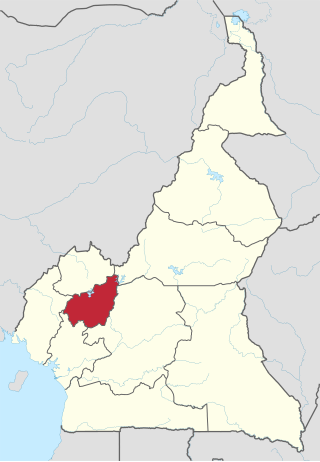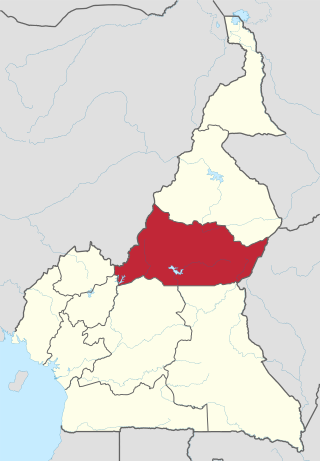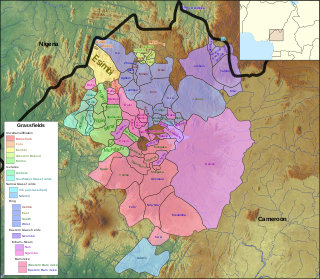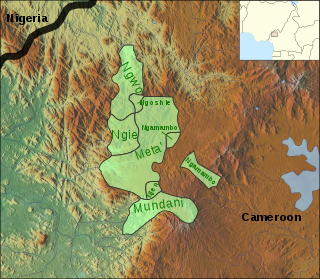Related Research Articles

The West Region is 14,000 km2 of territory located in the central-western portion of the Republic of Cameroon. It borders the Northwest Region to the northwest, the Adamawa Region to the northeast, the Centre Region to the southeast, the Littoral Region to the southwest, and the Southwest Region to the west. The West Region is the smallest of Cameroon's ten regions in area, yet it has the highest population density.

The Bamiléké are a group of 90 closely related peoples who inhabit the Western High Plateau of Cameroon. According to Dr John Feyou de Hapy, Bamiléké means people of faith.

Southern Bantoid is a branch of the Bantoid language family. It consists of the Bantu languages along with several small branches and isolates of eastern Nigeria and west-central Cameroon. Since the Bantu languages are spoken across most of Sub-Saharan Africa, Southern Bantoid comprises 643 languages as counted by Ethnologue, though many of these are mutually intelligible.

The Tivoid languages are a branch of the Southern Bantoid languages spoken in parts of Nigeria and Cameroon. The subfamily takes its name after Tiv, the most spoken language in the group.

The Tikar are a Central African people who inhabit the Adamawa Region and Northwest Region of Cameroon. They are known as great artists, artisans and storytellers. Once a nomadic people, some oral traditions trace the origin of the Tikar people to the Nile River Valley in present-day Sudan. Such ethnic groups were referred to in the 1969 official statistics as "Semi-Bantus" and "Sudanese Negroes." They speak a Northern Bantoid language called Tikar. One of the few African ethnic groups to practice a monotheistic traditional religion, the Tikar refer to God the Creator by the name Nyuy. They also have an extensive spiritual system of ancestral reverence.
Feʼfeʼ or commonly Feʼefeʼe, also known as Nufi or Bafang, is a Bamileke language spoken in Cameroon, around the town of Bafang. It was one of the four languages selected for option at the Collège Libermann at Douala.
The Bamileke languages are a group of Eastern Grassfields languages spoken by the Bamileke people in the Western High Plateau of Cameroon.

The Grassfields languages are a branch of the Southern Bantoid languages spoken in the Western High Plateau of Cameroon and some parts of Taraba state, Nigeria. Better known Grassfields languages include the Eastern Grassfields languages, Bamun, Yamba, Bali, and Bafut and the Ring languages, Kom, Nso, and Oku. Almost all of these languages are closely related, sharing approximately half of their vocabulary.
The Ring or Ring Road languages, spoken in the Western Grassfields of Cameroon, form a branch of the Narrow Grassfields languages. The best-known Ring language is Kom.

The Ngemba languages are a group of Eastern Grassfields languages of the Western High Plateau of Cameroon.
The Southwest Grassfields, traditionally called Western Momo when considered part of the Momo group or when Momo is included in Grassfields, are a small branch of the Southern Bantoid languages spoken in the Western grassfields of Cameroon.

The Momo languages are a group of Grassfields languages spoken in the Western High Plateau of Cameroon.
Chamba Leko is one of two languages spoken by the Chamba people, the other being Chamba Daka. It is a member of the Leko branch of Savanna languages, and is spoken across the northern Nigerian–Cameroonian border.

Ghɔmálá’, or Bamileke-Banjun (Bamiléké-Bandjoun), is a major Bamileke language of Cameroon.
Limbum is a Grassfields language of Cameroon, with a small number of speakers in Nigeria. It is used as a trade language by some, but is primarily the mother tongue of the Wimbum people, who live in Donga-Mantung division of the Northwest Region, at the top of the Ring Road.
Medumba is a Bamileke language of Cameroon. The people who speak it originate from the Nde division of the West Region of the country, with their main settlements in Bangangté, Bakong, Bangoulap, Bahouoc, Bagnoun and Tonga. It is a major Bamileke language, and is located in an area where sacred kingship played a pivotal role in government, justice, and diplomacy. The modern history of the Bamileke area, which was a German colony placed under French trusteeship by the League of Nations in 1919, is closely associated with the nationalist movement of the Union des Populations du Cameroun (UPC), which developed primarily in the coastal hinterland (Bassa) and the western highlands (Bamileke). From 1956 to the late 1960s, this area of Cameroon experienced a period of unrest; this episode continues to shape Bamileke political culture, and has an impact on language identity and the linguistic landscape.
Ngombale, or Ngombale Bamileke, is a Bamileke language of Cameroon.
Mengaka (Məgaka), or Mengaka Bamileke, is a Bamileke language of Cameroon. It was written in an indigenous script called Bagam.
Ndaʼndaʼ is a Bamileke language of Cameroon. Dialects are Ungameha and Undimeha ; Batoufam is a subdialect of the latter. It is also spoken in Batcha.
The Cameroon War is the name of the independence struggle between Cameroon's nationalist movement and France. The movement was spearheaded by the Cameroonian Peoples Union (UPC). Even after independence, the rebellion continued, shaping contemporary politics. The war began with riots in 1955 and continued after Cameroon gained independence in 1960. Following independence, the first President of Cameroon, Ahmadou Ahidjo requested continued French military intervention to fight the UPC rebels. The UPC rebellion was largely crushed by the Cameroonian Armed Forces and French Army by 1964. This war is often forgotten because it occurred at the height of France's biggest colonial independence struggle, the Algerian War.